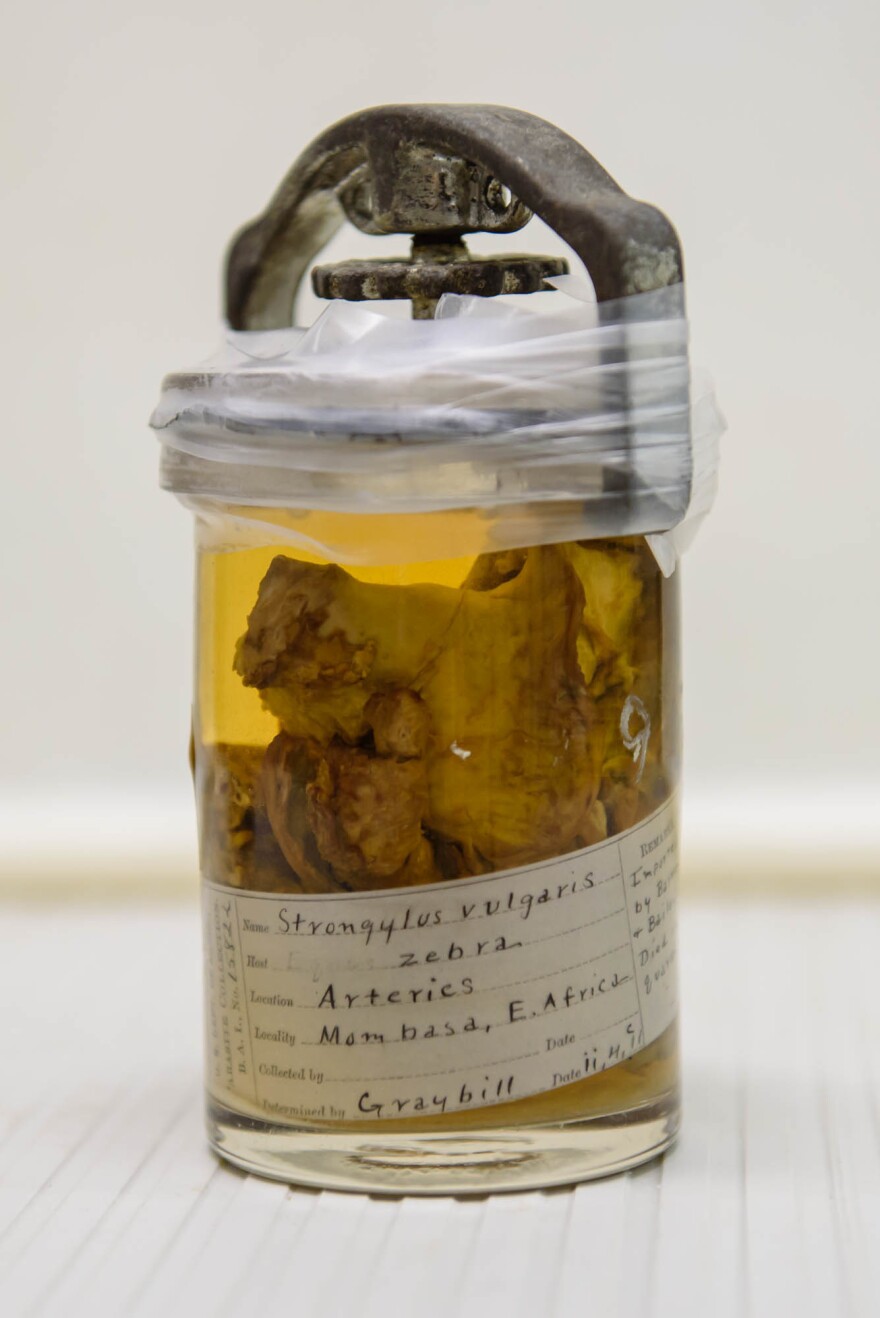Anna Phillips is surrounded by worms.
Millions of worms.
They're all stored in a hodgepodge of glass bottles, lined up on rolling, floor-to-ceiling shelves similar to the stacks at a major library or the vault of a data storage company.
Some bottles hold a single worm suspended in a formaldehyde solution. Other jars are packed with clumps of fleshy roundworms or long, languid tapeworms.

There are worms that arrived a few months ago. And a few that are more than 200 years old.
Phillips is a research zoologist at the Smithsonian's National Museum of Natural History. I met her at a nondescript warehouse run by the museum. It's located in suburban Maryland, a few blocks from a Metro station. And it houses one of the largest worm collections in the world. It's the perfect place to begin "Worm Week" — a series of stories about worms that will run in Goats and Soda.

The word "worm" actually applies to a wide variety of animals.
" 'Worm' is a common name for an organism that is long and thin," Phillips says. Then she adds "without legs." Then she clarifies even further with a laugh " ... that's not a snake!"
While this collection has all different kinds of parasitic worms, Phillips specializes in studying worms in birds. "Worms are incredibly successful in that they've occupied many different habitats in the world," she points out.
There are parasitic worms, earthworms, leeches (they're segmented worms). "There are worms that live in ice," she adds. "You go into glaciers and there are things called ice worms, and they appear in these balls in the glaciers."

Phillips doesn't have any ice worms or earthworms in this collection because they're not parasitic. The worms there are all part of the parasite collection, stored in a windowless, cement-walled room — a "pod," she calls it. It's climate-controlled, and an alarm goes off if you hold the metal door open too long.
This worm pod feels like an underground bunker even though it's on the second floor.
Parasitic worms are an incredibly diverse bunch. Some are microscopic. Others, such as tapeworms, can be 35 or 40 feet long. Some can make people and animals incredibly sick. Others ride around in us, cause no problems and may even be beneficial.
Phillips is hunting through the parasite stacks for a jar of roundworms from 1911. "The one that I'm looking for is a jar of nematodes from a zebra that was kept in quarantine when it was brought over for the Barnum and Bailey circus." The zebra died in quarantine. Nematodes or roundworms covers a broad category of worms that have tubular bodies, including hookworms and pinworms. They can flourish in plants, animals or humans. They're found on land, in lakes and in the ocean. See Sponge Bob.

The Smithsonian's parasite collection has more than 120,000 specimen lots — a "specimen lot" meaning one jar, jug, test tube or some other container. So finding the bottle of zebra roundworms is no easy task.
Phillips pulls out a glass jar with an oxidized metal clamp screwed onto its lid. She shakes the jar to try to get a better view of the label floating in the cloudy fluid. It's not the zebra roundworms.
"This looks like it was collected in Washington, D.C., from a deer in 1894," she says. Unlike the other jars that are packed with stringy worms, this one contains a blanched piece of flesh. You have to look closely to see the worms sticking out of it.
Phillips says when collecting parasitic worms in the field, it's often easier to leave the parasite lodged in the tissue it's burrowed into.
"Rather than pull out each individual worm, it may actually be quicker just to pull out the big chunk of tissue. Like this." She reaches down and picks up a jar from a shelf at knee level. "This is heartworm [from] a dog. So this is the actual heart with the worms inside. These long thin, stringy things. They're actually going through the passages of the heart. You can imagine if this dog's heart was full of heartworms, it wouldn't function very well."
The white, threadlike parasites are a strong visual reminder to give Fido his heartworm pills.

Phillips moves deeper into the stacks. "This shelf is all human parasites," she says. "A lot of the human ones come from hospitals."
There's a thin, silvery-white guinea worm in a medicine bottle collected in New York City in 1901. Phillips says it probably came from someone who'd recently traveled to the tropics, as guinea worm can't survive in the cold climate of New York.
Much of the collection comes from the U.S. Department of Agriculture, which started a parasite repository back in 1892. The USDA handed that collection over to the Smithsonian last year.
Phillips estimates there could be as many as 30 to 40 million parasites on the shelves behind her.
"The good news is that they [the parasites] are small, so we can fit the entire wet collection in here," she says. By "wet collection" she means the samples preserved in fluids as opposed to ones preserved on slides.
They have examples of human tapeworms that can grow to be 40 feet long. "Our literal specimen is probably not that long," Phillips says. "They tend to break up" when extracted from someone's gut.
Phillips concedes that the national parasite collection is an odd grouping of creatures. "Parasites are defined as a lifestyle," she says. So while a lot of the specimens are worms, many are not. There are jars with ticks, beetles and other insects.

This collection isn't open to the public the way the Smithsonian's museums are on the National Mall, but the Museum of Natural History makes this collection available to researchers. "There's a constant flow of international visitors," Phillips says. A lot of them come to compare worm samples they've just collected in the field against specimens in the archive, she says.
Researchers can see how, say, flatworms have changed in the course of 200 years.
Overall, the collection is a reminder of the long-standing relationship between humans and parasitic worms, who are one of the scourges of the developing world and take a toll in the U.S. as well.

But it's also a tribute to the fact that humans are really intrigued by these long, legless non-snakes.
As I'm getting ready to leave, I pick up a bottle that looks older than the ones around it. The handwriting on the label is small and crisp and appears to be from another era. It's the zebra roundworm.
A fleshy roundworm pokes out of a chunk of meat in the bottom of the thick glass bottle. It's from the zebra that never made it to the big top.
"You found it!" Phillips shouts with the enthusiasm of someone who clearly finds worms more fascinating than gross. "This is it!"
Copyright 2021 NPR. To see more, visit https://www.npr.org.




